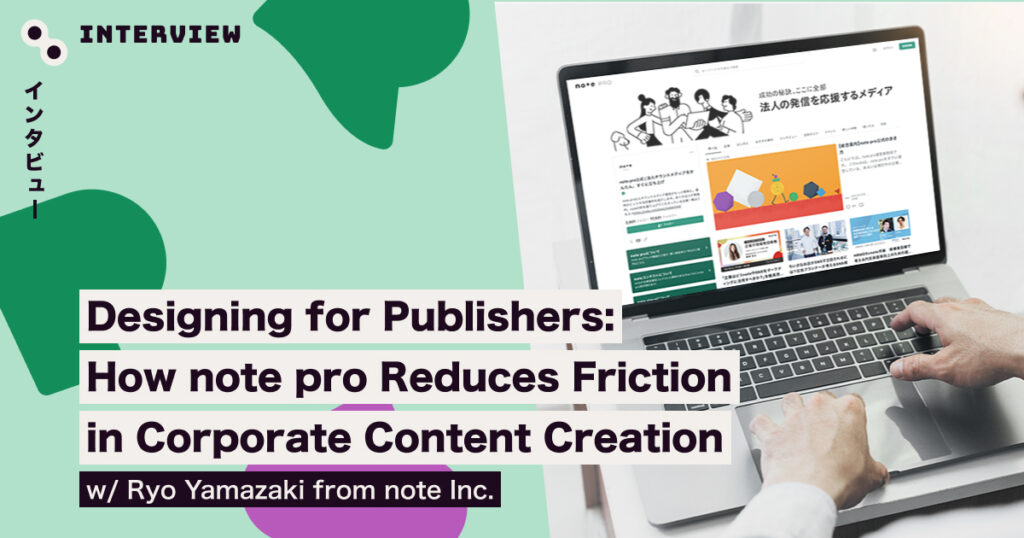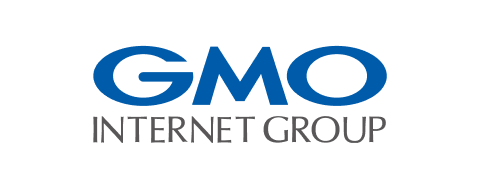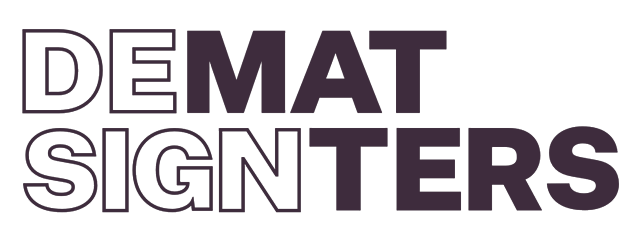Designing for Publishers: How note pro Reduces Friction in Corporate Content Creation
“note” is one of Japan’s leading media platforms. Among its services, “note pro” provides various functions for corporations, supporting them in building and managing their owned media. As writing and publishing articles is becoming increasingly common in business operations, we asked note how they understand and support these challenges.

Ryo Yamazaki | Product Designer, note Inc.
Ryo worked as a designer at both production and business companies before joining note Inc. in 2023. He currently works as a product designer for note pro, where he is responsible for developing new features and designing experiences that support customer success.
note pro: The Corporate Service Built on note’s Unique Vision
To begin, could you tell us a bit about “note pro”?
Ryo: “note pro” is a high-function plan for corporations, built on the foundation of the media platform “note.” It offers features and support that cover a wide range of purposes from branding and recruitment to community building, as well as helping companies connect with users and deepen their relationships. The service’s worldview follows that of note, and by using the same design system, we create a consistent user experience across both note and note pro.

Are there any differences in design philosophy between note and note pro?
Ryo: In line with our mission of “enabling anyone to start and continue creating,” note aims to be a platform open to everyone. In contrast, the goal of note pro is to support corporate business through content publishing, and this difference is reflected in the way the services are designed.
For example, when designing note, we rarely define a persona. Narrowing down the target risks limiting use cases and making the service convenient for some groups but inconvenient for others. Since note aims to cover both ends of that spectrum, the concept of a fixed persona doesn’t really fit.
On the other hand, note pro has a clear persona: the “corporate owned media manager.” That’s the major difference. Still, because each company’s communication goals vary, we design the functions and experiences with a broad range of use cases in mind.
When Publishing Becomes Part of the Job, Expectations Shift
What kinds of efforts did you make to understand the reality of corporate owned media managers?
Ryo: We conducted interviews about their work responsibilities, created customer journey maps, and held repeated discussions within the team.
As terms like “recruitment PR” gain attention, more and more companies, not only major IT firms in urban areas but also a wide variety of businesses, are putting effort into information dissemination. In many cases, people with no prior experience in publishing are suddenly appointed as content managers and tasked with producing articles right away. Since these individuals are often extremely busy with a wide range of responsibilities, we need them to be able to incorporate the regular writing and publishing of articles into their workflows. That’s why we aimed not only to understand the operation of owned media itself, but also to gain a deeper understanding of the managers’ overall duties and processes.

For regular note users, publishing is optional, but when it becomes part of someone’s job, does their approach change?
Ryo: That’s right. With note, you can write whenever you like, or simply read if you prefer and there are many ways to enjoy the platform. But when running an owned media as part of one’s work, the focus shifts: reducing the effort required for writing and publishing, and maximizing results, become much more important.
On note, for example, we’ve introduced features like “encouragement comments” that appear when you post an article, initiatives that emphasize qualitative aspects to boost user motivation. With note pro, however, what matters even more is achieving higher page views and turning efforts into tangible business outcomes.

Ryo: That said, not all managers have extensive writing experience, and their understanding of owned media varies widely. That’s why our Customer Success team communicates carefully with each client, suggesting things like what kind of articles to aim for and how frequently to publish, and providing tailored support.
It sounds like one of the strengths of note pro is not only its product features but also the reliable support from the Customer Success team.
Ryo: In the future, we may be able to turn some of that support into knowledge-based resources and provide it as a feature. For now, though, we believe that direct communication is more effective. This is especially true for small and mid-sized companies or organizations where PR and communications are handled by a single person. We often hear concerns about limited resources or a lack of colleagues to consult with. By being a partner they can turn to, the Customer Success team helps ensure they can keep publishing. We’re always conscious of finding the right balance between what can be solved through product features and what should be handled by people.
AI Writing Support: Leveraging the Expertise of the In-House Editor Team
What features did you design to reduce effort and maximize results?
Ryo: We offer three AI-powered features to help those who find writing challenging.
The first is the AI Assistant, a chat-style AI accessible directly from the writing interface for on-the-spot support (available to all users since April 2023). The second is AI Review (Beta), which checks articles on the publication settings screen and automatically alerts users if it detects any potentially problematic expressions. The third, and likely the most helpful for managers struggling with writing, is AI Writing Support, which can automatically generate and structure text based on recorded or audio data.
Having experience using AI to improve operational efficiency at note, we realized AI could also deliver value to our users. Many managers had difficulties such as “I don’t know the right way to write an article,” “Transcribing is tedious,” and “I can’t find time to write during work.” We developed AI features specifically to address these pain points.
Considering the challenges faced by managers, what kind of experience does AI Writing Support aim to provide?
Ryo: Many corporate publications are interview-based, which involve multiple steps: conducting interviews, transcribing, drafting outlines, and editing. This creates a heavy workload for managers. To ease this, we designed the system so that simply submitting interview data through a form and entering the interview format and number of participants can generate a well-structured article draft. Users’ familiarity with AI varies, so we minimize points of confusion such as adjusting prompts so anyone can use it easily and confidently.

Do you take any measures to ensure that each company’s personality comes through in the articles?
Ryo: Much of a company’s appeal and uniqueness comes from authentic, raw voices. That’s why we provide human-led support, such as sharing model articles and offering guidance on what to ask during interviews.
As for AI Writing Support, we provide four types of outputs together: transcription, Q&A summary, draft structure, and provisional draft, so that managers can choose according to their writing ability and style. Those who are confident in writing can build an article from the transcription and edit it to fit their vision, while those less comfortable can simply tweak a near-complete draft and publish quickly.
During development, we received feedback from note’s in-house editorial team, which helped us refine the prompts that generate these four outputs. Getting perspectives from professional editors was extremely valuable.
What kind of feedback did you receive?
Ryo: Feedback mainly concerned article length and tone/style.
For length, we received guidance on the appropriate word count relative to interview duration. For example, data from a one-hour interview was adjusted to produce drafts of roughly 3,000–5,000 characters. We iteratively refined the prompts to keep articles concise enough to maintain readers’ focus.
For style, we noted that simply converting spoken words into text often resulted in prose that was difficult to read. The editorial team helped us adjust the drafts so that the tone was neither too formal nor too casual, striking the right balance for readability.
What did you focus on most across AI Writing Support as a whole?
Ryo: AI technology is evolving rapidly, with even higher-performing models emerging within months. This made it challenging to decide which features to lock in and which to update. To test effectively, we prioritized quick releases and user feedback. For example, in the alpha version of AI Writing Support, we used an external service for the data upload form instead of building it in-house. While this is unusual for note, it reduced development effort and allowed us to validate the concept quickly.
Maintaining note’s Vision for the Long Term
Note pro differs from note in many ways. Have there been things you’ve decided not to do, or features you’ve considered in order to maintain consistency as a platform?
Ryo: We’re careful that note pro’s features don’t become something exclusively closed off to corporate users. Even if a feature serves only that group in the short term, we aim to design and implement it so that, in the long term, it could be available to all users. This approach helps maintain the overall consistency of note’s worldview. There are also cases where features from note are adapted for note pro, so we develop with both platforms in mind.
Additionally, we don’t prioritize note pro articles on the platform just to make them more visible. While preferential treatment might yield short-term results, it would undermine the recommendation system across note and negatively affect the overall user experience.
What’s important is long-term value for creators and growth across the entire service. We apply the same thinking to owned media management on note pro: results aren’t immediate within a month. Success comes over six months or a year as companies and readers gradually build communication. This aligns with note’s approach.
So, note’s worldview is firmly embedded in note pro as well.
Ryo: Another point related to note’s overall stance is that although we’ve implemented various AI-powered features, we take care to treat AI as a supportive tool that reduces the burden of publishing, not something that replaces creativity. No matter how good a feature is, it won’t actually be used unless it leaves users with a positive impression. We prioritize the creator’s perspective, ensuring that the tools feel empowering to use.
Making owned media feel “personal” for the future
Are there features or initiatives aimed at meeting the needs of companies seeking measurable results?
Ryo: We focus on how analytics data is presented, providing insights such as link clicks within articles and sources of search traffic. Reviewing this data and applying it to future content is crucial for maintaining effective, ongoing publishing.
However, publishing through owned media itself is still far from being considered a routine task for many companies. There are few services comparable to note pro, and the knowledge required to run a continuous PDCA (Plan-Do-Check-Act) cycle is not yet common.
That makes sense. Even when companies do track performance, it’s often through production support agencies rather than internally.
Ryo: Many managers have little to no experience interacting directly with analytics data, and even when we present it, key points can be overlooked. That’s why we iteratively refine data labeling and presentation, checking managers’ reactions as we go.
For example, we have an analysis feature that shows “readers’ interests,” helping managers understand what topics their audience is engaging with. Originally, it was called “audience attributes,” but we renamed it to make the purpose immediately clear and added explanations on how to leverage the data, so managers can more easily apply insights to improve their content.

Ryo: Many managers don’t normally handle writing or publishing tasks, so the word choices we assume will “get the message across” aren’t always optimal. That’s why it’s essential to hear directly from users and adjust accordingly.
Overall, we recognize that owned media is still something managers often struggle to make “their own,” and that requires deliberate effort.
Additionally, corporate content publishing isn’t a “must-have” task like HR or administrative duties. It’s more of a “nice-to-have.” Yet, it still needs to be incorporated alongside their regular work.
Given that, any benefit like reducing workload or lowering the publishing barrier can’t just make things “a little easier.” It has to make the work dramatically easier. Most widely adopted B2B services are must-have tools, so for a nice-to-have service like note pro, the goal is to enable a transformational change in workflow. Keeping this in mind is central to how we approach feature development and improvements moving forward.
Finally, could you share your outlook for the future?
Ryo: Beyond supporting continuous publishing, we aim to further enhance how note pro drives corporate business outcomes. By leveraging the broad audience of the note platform and the expertise of its creators, we seek to bring even greater value to note pro turning page views into measurable business results.
Special Thanks to:
note Inc.
note pro Service Page https://pro.lp-note.com/








